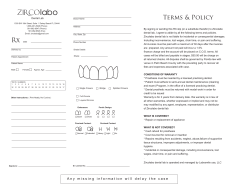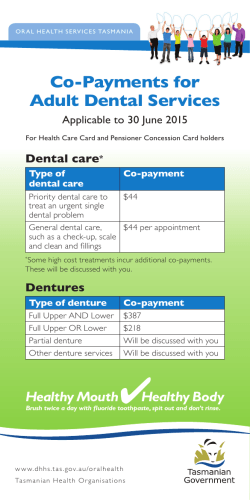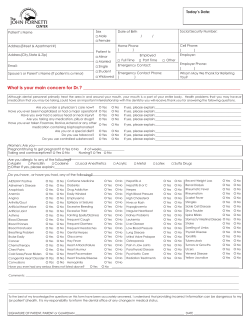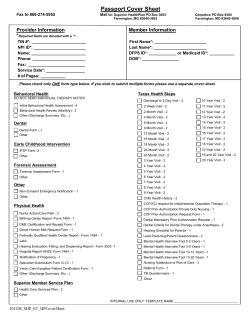
frequency of dental erosion and risk factors – a study
Original Article FREQUENCY OF DENTAL EROSION AND RISK FACTORS – A STUDY SAMIULLAH KHAN, BDS SYED NASIR SHAH, BDS, FCPS (Prosthodontics) 1 2 ABSTRACT The objective of current study was to determine the frequency and risk factors of dental erosion and its grades at presentation and to find frequency of common risk factors i.e. acid regurgitation, vomiting, carbonated drinks and occupational acidic environment among patients presenting with highly suspected clinical features This Cross-sectional descriptive study with sample size of 264 was conducted at Prosthodontic Department, Sardar Begum Dental College, University Town, Peshawar from 17th May 2012 to 17th December 2012. Patients with age 18 years or above of both gender presenting with highly suspected clinical features were subjected to detailed oral and dental examination. Nature of tooth surface loss (attrition, abrasion, erosion) was recorded in specially prepared proforma. Patients having dental erosion were graded according to Eccles and Jenkins Index and they were carefully scrutinized for risk factors. One tooth with highest grade of erosion was considered for assessment. Teeth with caries, fractured, with restorations and congenital anomalies were not considered for grading and were excluded. Results showed mean age of the patients was 38.34 years, SD ±10.968. The tooth wear due to dental erosion among study subjects was recorded 73.5% and due to abrasion and attrition was 26.5%. The most common risk factor was carbonated drinks which was 19.7%. Other risk factors were vomiting (13.3%), occupational erosion (7.6%), acid regurgitation (17%), carbonated drinks+acid regurgitation (7.6%), carbonated drinks+occupational erosion (8.3%). The grades of erosion according to Eccles and Jenkins Index was 29.2% in grade- 1 and 44.3% erosion was in grade-2 and no patient was observed with grade-3. Majority of patients were in age group 42-49 (25.4%). Patients in age group 18-25 were 13.3%. It was concluded that risk factors i.e. carbonated drinks, vomiting, acid regurgitation, and occupational hazards may lead to dental erosion. Key Words: Tooth erosion, carbonated beverages, vomiting, occupational exposure, Risk factors. INTRODUCTION Dental erosion or chemical wearing away of the tooth structure is a dental health problem of the modern world. If not detected early, may result in serious irreversible damage to dentition. An awareness of its clinical appearance, etiology, and risk factor is import For corresepondance: Dr Syed Nasir Shah, Department of Prosthodontic, Sardar Begum Dental College and Hospital, Canal Road, University Town, Peshawar. Email: drsamiullah.khan@yahoo.com Mobile: 0333-9208868 1 Fcps-II Trainee Department Prosthodontic, Sardar Begum Dental College and Hospital, University Town, Peshawar. 2 Associate Professor and Head of Department of Prosthodontic Department, Sardar Begum Dental College and Hospital, Canal Road University Town, Peshawar Received for Publication: September 19, 2014 Revision Received: October 1, 2014 Revision Accepted: October 12, 2014 Pakistan Oral & Dental Journal Vol 34, No. 4 (December 2014) ant to plan the preventive and curative management of such problem.1 Lifestyle changes and a rise in the consumption of acidic foods and beverages have led to an increase in the prevalence of dental erosion around the world in recent years. High prevalence numbers ranging from 30%7 to 68%8 have been reported, especially among children and adolescents.2 Tooth erosion and other tooth wears can be assessed from tooth wear indices (TWI) like Eccles index, Lussi index, Smith and Knight index, Simplified scoring criteria and Eccles and Jenkins index. Eccles and Jenkins erosion index classify the severity of dental erosion into four levels: Level 0; Normal surface, without enamel wear. Level 1; Surface with enamel wear but without 756 Dental Erosion and Risk Factors dentin wear. Level 2; Surface with dentin wear less than 1/3 of the surface and the highest severity. Level 3; Surface with dentin wear more than 1/3 of the surface.3,4 If dental erosion is not controlled and stabilized, the child may suffer from severe tooth surface loss, tooth sensitivity, irregular occlusal plane, dentoalveolar compensation, over closure, poor aesthetics, or even dental abscesses in the affected teeth.5,6 Epidemiologic surveys have investigated dental erosion in developed and developing countries. The prevalence of dental erosion varies considerably in different countries, geographic locations, and age groups as shown in Table 1.7 In Peshawar region published studies about frequency of dental erosion and its risk factors are rare. So the aim of current study was to find the severity of dental erosion and risk factors in this region and also to assess the reasons behind the difference between current results and international statistics. METHODOLOGY This cross-sectional descriptive study with sample size of 264 was conducted at Prosthodontic Department Sardar Begum Dental College University Town, Pe- shawar. Patients of 18 years or above of both gender presenting with highly suspected clinical features i.e. (flattening or loss of incisal edges and cusps, loss of enamel which shows dentine, cupping of cusps and fissures, wear facets, v shaped lesion) were subjected to detailed oral and dental examination. Nature of tooth surface loss (attrition, abrasion, erosion) was recorded in specially prepared Proforma. Patients having dental erosion were graded according to Eccles and Jenkins index and they were carefully scrutinized for common factors leading to it i.e. acid regurgitation, vomiting, carbonated drinks and history of exposure to occupational environments. Most of the patients had dental erosion of different grades (severity) in multiple teeth. In those cases the highest grade was recorded and considered. Teeth with caries, fractured, with restorations and congenital anomalies were not considered for grading and were excluded. All information including name, age and gender were recorded in the proforma. The data were analyzed in statistical package for social sciences (SPSS) version 17. Mean + Standard Deviation were calculated for numerical variables like age, frequencies and percentages were calculated for categorical variables like gender, dental erosion, its grades (grade 1, 2, and 3) and risk factors. TABLE 1: PREVALENCE OF DENTAL EROSION IN DIFFERENT COUNTRIES Author Year Country Age 14 11-13 Sample size 418 125 Present (%) 100 37 Exposed Dentine (%) 52 0 Al-Dlaigan Deery 2001 2000 UK UK Ganss Peres 2001 2005 German Brazil 11.4 12 1000 499 11.6 13.0 0.2 0.32 Caglar EL Karim 2005 2007 Turkey Sudan 11 12-14 153 157 28 66.9 0 0 Auad Waterhouse Talebi 2007 2008 2009 Brazil Brazil Iran 13-14 13-14 12 458 458 483 34.1 341 38.1 0 0 4.0 Correr 2009 Brazil 12 389 26 35 Teeth examined All permanent teeth Upper permanent incisors All permanent teeth Upper permanent incisors All permanent teeth Upper permanent incisors All permanent teeth All permanent teeth Upper permanent incisors All permanent teeth TABLE 2: AGE GROUP AND GENDER DISTRIBUTION Age group of patient 18-25 26-33 34-41 42-49 50 and above Total Gender of patient Male Female 24 11 30 30 22 43 30 37 19 125 Pakistan Oral & Dental Journal Vol 34, No. 4 (December 2014) 18 139 Total Percentage 35 60 65 67 13.3 22.7 24.6 25.4 37 264 14 100 757 Dental Erosion and Risk Factors TABLE 3: DISTRIBUTION OF TOOTH WEAR WITH GENDER Type of tooth wear Gender of patient Male Total Percentage Female Dental erosion 103 91 194 73.5 Other tooth wear (attrition, abrsion) 22 48 70 26.5 Total 125 139 264 100 TABLE 4: DISTRIBUTION OF GRADES OF EROSION OF DIFFERENT RISK FACTORS Grade of erosion Risk factors of dental erosion Other tooth wears Total Carbonated drinks Acid reguritation Vomiting Carbonated drinks+occupational erosion Carbonated drinks + acid regurgitation Carbonated drinks + acid regurgitation Grade 1 29 16 17 10 1 4 77 Grade 2 23 29 18 12 19 16 117 Total 52 45 35 22 20 20 194 19.7 17 13.3 8.3 7.6 7.6 Percentage Occupa tional erosion 26.5 100 TABLE 5: DISTRIBUTION OF GRADES OF EROSION WITH GENDER Grade of erosion Gender of patient Total Percentage 37 77 29.2 63 54 117 44.3 Other tooth wear (attrition, abrasion) 22 48 70 26.5 Total 125 139 264 100 Male Female Grade 1 40 Grade 2 RESULTS The patient’s age ranged from 18-66 years. The mean age was 38.34 years ±10.968 (SD). Patients in age group 42-49 years were in the highest number (67) while patients in age group of 18-25 were in the lowest number (35). (Table 2). Two hundred and sixty four patients formed the study group. One hundred and ninety four (73.5%) patients were found to be suffering from dental erosion and 70 patients (26.5%) were observed with other type of tooth wear like attrition and abrasion. (Table 3, Fig 1). The most common risk factors causing dental erosion were found to be carbonated drinks i.e. 52 (19.7%) patients. The least common risk factor was occupational erosion i.e. is 20 (7.6%). Carbonated beverages were found to be the commonest risk factor in both genders (26 patients each). The least common risk factor in Pakistan Oral & Dental Journal Vol 34, No. 4 (December 2014) females was occupational erosion (2 patients). The least common risk factor in males was vomiting (10 patients). (Table 4, Fig 2). In 194 patients of dental erosion, 77 (29.2%) patients had grade-1 dental erosion and 117 (44.3%) were found in grade-2. No patient was observed with grade-3 dental erosion. Gender wise distribution of grade-1 dental erosion in male and females was 40 and 37 respectively. Gender wise distribution of grade-2 dental erosion in males and females 63 and 54 respectively, (Table 5). DISCUSSION Epidemiological studies have reported that dental erosion is common in adolescents. Dental erosion was found 37% in the UK and 41% in the US.8 Kazoullis S et al reported tooth erosion was 68%.9 Mcguire J et al reported tooth erosion as 45.9%.10 In this study it was 73.48% which is much more than the above mentioned Studies. The difference between the statistics of the 758 Dental Erosion and Risk Factors Fig 1: Distribution of tooth wear according to age groups Fig 2: Distribution of risk factors within different age groups present study and other studies was due to difference in the life style, decreased literacy rate, poverty, lack of awareness and lack of facilities avaliable. Above mentioned studies were community based but current study was done on patients who visited our college hospital. Suyama Y et al observed 22.5% occupational erosion.11 Tuominen M and Tuominen R observed occupational erosion 15%.12 Kim and Douglass reported 5% occupational enamel erosion and 3% dentine erosion.13 In this study occupational erosion was 7.6%, perhaps due to less number of industries. Acid regurgitation is another risk factor of tooth erosion. In this study erosion due to acid regurgitation was 17%. In study done by Munoz et al found dental erosion due to acid regurgitation was 47.5%.14 Schroeder Pakistan Oral & Dental Journal Vol 34, No. 4 (December 2014) et al found tooth erosion in gastro-esophgeal reflux disease patients as 40%.15 While in the study of Rado RE et al observed 20%.16 Our results of the present study about the acid regurgitation as a risk factor for dental erosion fall within the range of international studies. In western countries acid regurgitation are mostly due to alcohol drinking.17,18 Wang P et al reported 30.7% of dental erosion due to carbonated drinks.7 Kannan A et al observed 17.65%19 and Hamasha AA et al reported 33.6%.20 In the current study erosion due to carbonated beverages was 19.7%. Which is the most common risk factor found in tooth erosion in this study. The reason for being carbonated drinks as the commonest risk factor is that Pakistan has long summer season and people use excessive carbonated beverages due to thirst and fluid loss. There has been a sharp increase in the consumption 759 Dental Erosion and Risk Factors of carbonated drinks, fruit juices and squashes in the last few years since the multinational companies are involved in effective advertisement. But the dilemma in this part of the region is that many unregistered local companies are also manufacturing carbonated beverages. 12.5% tooth erosion due to vomiting was observed in the study done by wang p et al.7 In present study tooth erosion due to vomiting was 13.3%. Most youngsters especially females of our society are involved in eating disorders of psychosomatic origin such as nervous vomiting, bulimia nervosa which causes self induced vomiting.21,22 Other causes of chronic excessive vomiting in this society are GIT disorders like peptic ulcers or gastritis, drug side effects, diabetes or nervous system disorders. The distribution of tooth erosion with any gender is not specific as it is different in different parts of the world. Wang P et al7 reported tooth erosion in male 25.7% and in female 29.9%. Nayak SS et al23 reported tooth erosion in females 26.73% and in males 15.50%. Shah SA24 reported tooth erosion in male 44.3% and in female 55.7%. In the current study the dental erosion in males and females was 47.3% and 52.7% respectively. Tooth erosion in the present study was not specific to single age group. The same results have been reported in a study conducted by Shah SA.24 CONCLUSION Most common grade of erosion according to Eccles and Jenkins index in this society was grade-2 and least common was grade-3. Frequent dental erosion in this study was due to carbonated beverages and acid regurgitation. Dental erosion was not associated with any particular age group as it was equally distributed among patients of all ages. REFERENCES 7 Wang P, Lin HC, Chen JH, Liang HY. The prevalence of dental erosion and Associated risk factors in 12-13-year old school children in southern china. BMC Public Health 2010;10(478):1-9. available from :URL: www.biomedcentral. com/1471- 2458/10/478. 8 Deery C, Wagner ML, Longbottom C, Simon R, Nugent ZJ. The prevalence of dental erosion In a United States and a United Kingdom sample of adolescents. Pediatr Dent 2000; 22: 505-10. 9 Kazoullis S, Seow W, Holcombe T, Newman B, Ford D. Common dental conditions associated with dental erosion in schoolchildren in Australia. Pediatr Dent 2007; 29: 33-39. 10 Mcguire J, Szabo A, Jackon S, Bradley TG, Okunseri C. Erosive tooth wear among children in the united states : relationship to race/ethnicity and obesity. Int J Paediatr Dent 2009; 19: 91-98. 11 Suyama Y, Takaku S, Okawa Y, Matsukubo T. Dental erosion in workers exposed to sulfuric acid in lead storage battery manufacturing facility. Bull Tokyo dent coll 2010; 51(2): 77-83. 12 Tuominen M, Tuominen R. Tooth surface loss and associated factors among factory workers in Finland and Tanzania. Community Dent Health 1992; 9: 143-50. 13 Kim HD, Douglass CW. Associations between occupational health behaviors and occupational dental erosion. J Public Health Dent 2003; 63: 244-49. 14 Munoz JV, Herreros B, Sanchiz V. Dental and periodontal lesions in patients with gastro-oesophageal reflux disease. Dig Liver Dis 2003; 35: 461-67. 15 Schroeder PL, Filler SJ, Ramirez B,Lazarchik DA, Vaezi MF, Richter JE. Dental erosion and acid reflux disease. Ann Intern Med 1995; 122: 809-15. 16 Rado RE. Dental erosion due to GERD in patients with developmental disabilities: Case theory. Spec care Dentist 2014; 34(1): 7-11. 17 Hung CS, Lee CL, Yang JN, Liao PT, Tu TC, Chen TK, Wu CH. Clinical application of Carlsson’s questionnaire to predict erosive GERD among healthy Chinese. Journal of Gastroenterology and Hepatology 2005; 20(12): 1900-905. 18 Wang JH, Luo JY, Dong L, Gong J, Tong M. Epidemiology of gastroesophageal reflux disease: a general population-based study in Xi’an of Northwest China. World Journal of Gastroenterology 2004; 10(11): 1647-651. 19 Kannan A, Ahmad MA, Duraisamy P, Manipal S, Adusumillil P. Dental hard tissue erosion rates and soft drinks-A gender based analysis in Chennai City India. The Saudi journal for dental research 2014; 5: 21-27. 1 Gupta M, Pandit Ik, Srivastava N, Gugnani N. Dental erosion in children. J Oral Health Comm Dent 2009; 3(3): 56-61. 20 Hamasha AA, Zawaideh FI, Al-Hadithy RT. Risk indicators associated with dental erosion among Jordanian school children aged 12-14 years of age. Int J Paediatr Dent 2014; 24: 56-68. 2 Badr SBY, Ibrahim MA. Protective effect of different fluoride pretreatments on artificially induced dental erosion in primary and permanent teeth. Journal of American science 2010; 6(11): 442-51. 21 Choudry IY & Mumford DB. A pilot study of Eating Disorders in Mirpur (Pakistan) using an Urdu version of the Eating Attitudes Test. Int J of Eat Disord 1992; 11: 243-51. 3 Bardsley PF. The evolution of tooth wear indices. Clin Oral Invest 2008; 12 (1): 15-19. 22 Mumford DB, Whitehouse AM, Choudry IY. Survey of Eating Disorders. In English medium schools in Lahore, Pakistan. Int J Eat Disord 1992; 11: 173-84. 4 Manarte P, Manso MC, Souza D, Bulhosa JF, Gago S. Dental erosion in alcoholic patients under addiction rehabilitation therapy. J Med Oral Patol Oral Cir Bucal 2009; 14(8): 377-84. 23 Nayak SS, Ashok kumar BR, Ankola AV, Hebbal M. Dental erosion among 12 year old school children in belgaum city-A cross sectional study. Pak Pead J 2009; 33(1): 48-57. 5 Lussi A, Schaffner M, Jaeggi T. Dental erosion - diagnosis and prevention in children and adults. Int Dent J 2007; 57(6): 38598. 24 Shah SA, Kanwal H. Intensity of dental erosion in age groups. PODJ 2013; 33(1): 131-36. 6 Kaifu Y. Tooth wear and compensatory modification of the anterior dentoalveolar complex in humans. Am J Phys Anthropol 2000; 111(3): 369-92. Pakistan Oral & Dental Journal Vol 34, No. 4 (December 2014) 760
© Copyright 2025









